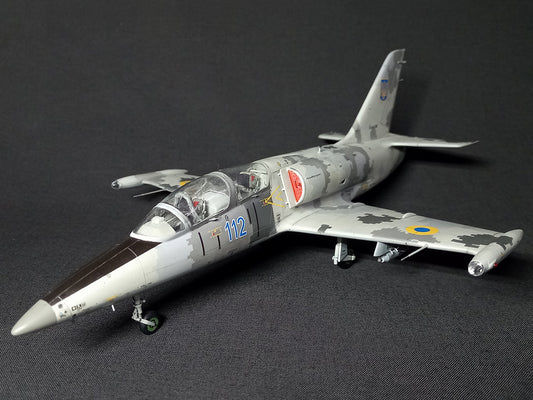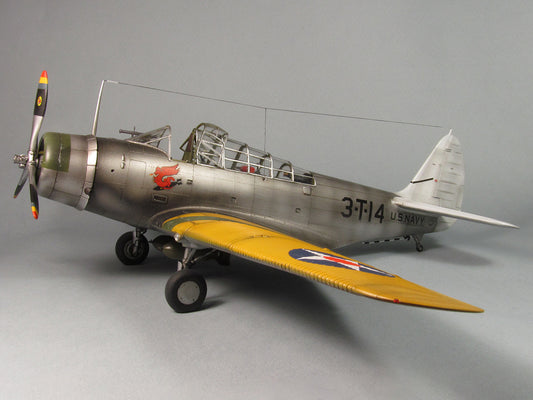By Andriy Kudelin, Ukraine
RS Models, 1/72
The Junkers Ju 86: A Versatile Workhorse
The Junkers Ju 86 was more than just a German monoplane bomber; it was a versatile aircraft that also served as a civilian airliner. Its story begins in the early 1930s when the German airline, Luft Hansa, sought a modern twin-engined aircraft that could operate as a high-speed airliner and a medium bomber for the burgeoning Luftwaffe. This led to a competition between Junkers and Heinkel, with each company tasked to create five prototypes. Junkers produced the Ju 86, and Heinkel, the He 111.
Junkers' design was groundbreaking for its time. Unlike its predecessors, it featured a low-winged twin-engined monoplane with an all-metal stressed skin construction. This design marked a departure from Junkers' signature corrugated skinning in favor of smooth metal skin, reducing drag and enhancing aerodynamics. The aircraft was equipped with a narrow track retractable-main gear conventional undercarriage with a fixed tailwheel. Additionally, it boasted twin fins and rudders. The intention was to power the Ju 86 with the Junkers Jumo 205 diesel engines. While these engines were heavier, they offered better fuel efficiency compared to conventional petrol engines.
The Ju 86 made its combat debut during the Spanish Civil War, serving with the Condor Legion. Although it arrived in Spain in 1937, its combat career was brief. After a few sorties, one Ju 86 was shot down by Republican fighters, marking the end of its Spanish service.
As World War II dawned, the Ju 86 still saw some service. A single group of Ju 86 bombers remained in operation during the 1939 invasion of Poland. However, these were quickly replaced. The diesel-engined Ju 86A and D variants were retired, while the radial-engined Ju 86E and G models were transferred to bomber training schools.
In January 1940, the Luftwaffe tested the Ju 86P prototype. This aircraft featured a longer wingspan, a pressurized cabin, and powerful Junkers Jumo 207A-1 turbocharged two-stroke, opposed-piston diesel engines. With a two-man crew, the Ju 86P could reach altitudes of over 12,000 meters (39,000 feet). This high altitude was considered a safe zone away from enemy fighters. However, the RAF created a special interception squadron using modified Spitfire Mk IXs, and in September 1942, one Ju 86P was shot down over England. Subsequent flights over England were discontinued. In August 1942, a modified Supermarine Spitfire Mark V shot down another Ju 86P over Egypt at an astounding altitude of about 14,500 meters (49,000 feet). This led to the withdrawal of Ju 86Ps from service in 1943.

Junkers continued to innovate, developing the Ju 86R for the Luftwaffe. This version featured larger wings and new engines, capable of reaching even higher altitudes, up to 16,000 meters (52,500 feet). However, production remained limited to prototypes.
The Ju 86R Model Build
In the world of scale aircraft modeling, it's often the lesser-known planes with unique stories that capture the imagination of enthusiasts. The Junkers Ju 86R, a specialized high-altitude reconnaissance aircraft developed for the German Luftwaffe, is one such hidden gem in aviation history. In this blog post, we'll take you through the fascinating journey of modeling the Ju 86R and delve into the intricacies of crafting a lesser-known, yet historically significant aircraft.
The RS Models Kit
When it comes to scale model kits, the Junkers Ju 86R offered by the Czech company RS Models stands as an almost exclusive choice.

This kit, like many others from the region, is what modelers often refer to as a "short-run" kit. What does that mean? It might not overflow with details, but it contains everything you need to create a quality model. For a detailed look at the kit's contents, you can visit the official manufacturer's website.
The Craftsmanship Begins: Building the Kit
Our modeling journey typically kicks off in the cockpit. The Ju 86R had a crew of only two, so unlike its bomber variant, there was no need to create gunner positions. However, despite having just two crew members, the cockpit featured quite a large glazed area. This was because this version of the Junkers Ju 86 was designed for high-altitude photo reconnaissance missions, requiring excellent visibility. I assembled and enhanced the pilot's cockpit, utilizing components from the kit and crafting some additional details myself.

One of the crucial aspects was replicating the numerous instrument panels this aircraft boasted. I took extra care to capture the instrument panel's essence, as this plane had quite a few. I also focused on the engine control levers. These levers were painted in distinct colors: red RLM 23, white RLM 21, black RLM 22, yellow RLM 27, and green RLM 25. Radio equipment received its due attention and was painted black-gray RLM 66.

For added realism, I included seat belts on the crew seats. The entire pilot's cockpit was painted in the standard interior gray color for Luftwaffe aircraft: RLM 02. Despite the extensive glazed area, some of the intricate detailing proved to be nearly invisible on the finished model due to the canopy's complex design.
After completing the pilot's cockpit, I shifted my focus to the airframe. Due to the aircraft's intended operations at high altitudes in rarified atmospheres, it sported impressively long wings. While this feature lent the model an impressive look, it posed certain challenges during assembly and painting.
Painting the Junkers Ju 86R
The first step in painting our completed airframe was applying the base coat of RLM 02. To prevent our sizable monochrome aircraft from becoming a gray behemoth on the shelf, I opted for a technique known as "pre-shading". This method works wonders in bringing depth and realism to the model, beyond its aesthetic appeal. Unlike the traditional black pre-shading, I chose a green shade, RLM 82, to emphasize the greenish tint of the RLM 02 paint.


Given that the aircraft was equipped with diesel engines, which produce considerably more soot compared to their gasoline counterparts, I meticulously crafted abundant soot and exhaust stains around the engine nacelles and exhaust pipes.
The real aircraft belonged to 2.(F)/123, based in Castelli, Crete in 1942. It sported white wingtips and a fuselage band – distinctive markings for swift identification of Axis powers in the Mediterranean theater of operations. While the usual choice for such markings is white RLM 21, it tends to have a slightly creamy hue. Opting for the whitest shade in the Arcus palette provided a striking contrast to the main camouflage color.



Moving on, I meticulously painted fine details, including propellers and landing gear components. The wheel wells and associated detailing were also coated in RLM 02, as this color was predominantly used for this purpose. Interestingly, the external surfaces of the aircraft were also painted in RLM 02, a common practice for painting Luftwaffe prototypes of the time.


The wheels were painted in black RLM 22, aligning with standard practice. To add an artistic flair, I painted shock absorber dust covers in RLM 26, and visible parts of the struts in a bright aluminum hue. The engine propeller blades stood out as one of the few components distinctly colored from the prevailing RLM 02 on this model. They received a coat of black-green RLM 70. The silver mechanisms controlling the pitch of the propeller added an extra layer of detailing and created a striking contrast between the dark-green blades and the grayish-green spinner.

With the detailing of the Ju 86R complete, I proceeded to apply a full coat of gloss varnish. Decals were skillfully applied, and panel lines received an artistic wash. A final layer of matte varnish was added, securing the details in place. The masking tape from the cockpit canopy was gently removed.

The Culmination: A Striking Addition to the Collection
In my opinion, the model turned out exceptionally well and will be a standout piece on my display shelf.
Happy modeling to you all!
Warm regards,
Andrіy.
(Edited and Translated by Mykhailo Orlov)





















